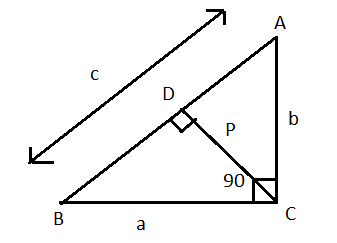
ABC is right triangle right angled at C. If P is the length of the perpendicular from C to AB and a, b, c have the usual meaning, then \[\dfrac{1}{{{a}^{2}}}+\dfrac{1}{{{b}^{2}}}\] is……………..
A. \[\dfrac{1}{{{p}^{2}}}\]
B. \[\dfrac{2}{{{p}^{2}}}\]
C. \[{{p}^{2}}\]
D. \[2{{p}^{2}}\]
Answer
587.4k+ views
Hint: If two angles of a triangle have equal to the measures of two angles of another triangle, then the triangles are similar. In similar triangles the ratio of corresponding sides is equal.
Complete step by step solution:

Now, In triangle ABC and BCD
\[\angle \text{B = }\angle \text{B}\] (common angle in each triangle)
\[\angle \text{ACB = }\angle \text{CDB}\] (90 each angle)
By the property of similar triangles, two angles are common.
\[\therefore \Delta \text{ABC }\sim \text{ }\!\!\Delta\!\!\text{ BCD}\] (by Angle – Angle rule)
So, By basic proportionality ratio
\[\dfrac{AB}{BC}=\dfrac{AC}{CD}\]
\[\dfrac{c}{a}=\dfrac{b}{p}\]
\[c=\dfrac{ab}{p}\]
By Pythagoras theorem on\[\to A{{B}^{2}}=A{{C}^{2}}+B{{C}^{2}}\]
\[{{c}^{2}}={{a}^{2}}+{{b}^{2}}\]
On putting the value of c
\[\dfrac{{{a}^{2}}{{b}^{2}}}{{{p}^{2}}}={{a}^{2}}+{{b}^{2}}\]
Dividing by \[{{a}^{2}}{{b}^{2}}\]to both sides, \[\dfrac{1}{{{p}^{2}}}=\dfrac{1}{{{a}^{2}}}+\dfrac{1}{{{b}^{2}}}\]
NOTE: Pythagoras attributed that the square of the hypotenuse of a right – angle triangle is equal to the sum of the squares on the other two sides.
When we prove two triangles are similar so we can only equate the ratio of corresponding sides of given triangles. So we need to choose corresponding sides carefully.
Complete step by step solution:

Now, In triangle ABC and BCD
\[\angle \text{B = }\angle \text{B}\] (common angle in each triangle)
\[\angle \text{ACB = }\angle \text{CDB}\] (90 each angle)
By the property of similar triangles, two angles are common.
\[\therefore \Delta \text{ABC }\sim \text{ }\!\!\Delta\!\!\text{ BCD}\] (by Angle – Angle rule)
So, By basic proportionality ratio
\[\dfrac{AB}{BC}=\dfrac{AC}{CD}\]
\[\dfrac{c}{a}=\dfrac{b}{p}\]
\[c=\dfrac{ab}{p}\]
By Pythagoras theorem on\[\to A{{B}^{2}}=A{{C}^{2}}+B{{C}^{2}}\]
\[{{c}^{2}}={{a}^{2}}+{{b}^{2}}\]
On putting the value of c
\[\dfrac{{{a}^{2}}{{b}^{2}}}{{{p}^{2}}}={{a}^{2}}+{{b}^{2}}\]
Dividing by \[{{a}^{2}}{{b}^{2}}\]to both sides, \[\dfrac{1}{{{p}^{2}}}=\dfrac{1}{{{a}^{2}}}+\dfrac{1}{{{b}^{2}}}\]
NOTE: Pythagoras attributed that the square of the hypotenuse of a right – angle triangle is equal to the sum of the squares on the other two sides.
When we prove two triangles are similar so we can only equate the ratio of corresponding sides of given triangles. So we need to choose corresponding sides carefully.
Recently Updated Pages
Master Class 8 Maths: Engaging Questions & Answers for Success

Class 8 Question and Answer - Your Ultimate Solutions Guide

Master Class 7 Maths: Engaging Questions & Answers for Success

Class 7 Question and Answer - Your Ultimate Solutions Guide

Master Class 6 Maths: Engaging Questions & Answers for Success

Class 6 Question and Answer - Your Ultimate Solutions Guide

Trending doubts
Why is there a time difference of about 5 hours between class 10 social science CBSE

Write a letter to the principal requesting him to grant class 10 english CBSE

What is the median of the first 10 natural numbers class 10 maths CBSE

The Equation xxx + 2 is Satisfied when x is Equal to Class 10 Maths

Which of the following does not have a fundamental class 10 physics CBSE

State and prove converse of BPT Basic Proportionality class 10 maths CBSE




